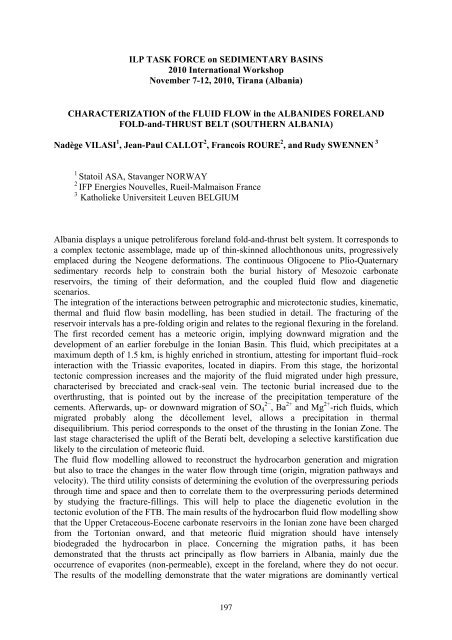DYNAMICS and ACTIVE PROCESSES - International Lithosphere ...
DYNAMICS and ACTIVE PROCESSES - International Lithosphere ...
DYNAMICS and ACTIVE PROCESSES - International Lithosphere ...
You also want an ePaper? Increase the reach of your titles
YUMPU automatically turns print PDFs into web optimized ePapers that Google loves.
ILP TASK FORCE on SEDIMENTARY BASINS<br />
2010 <strong>International</strong> Workshop<br />
November 7-12, 2010, Tirana (Albania)<br />
CHARACTERIZATION of the FLUID FLOW in the ALBANIDES FORELAND<br />
FOLD-<strong>and</strong>-THRUST BELT (SOUTHERN ALBANIA)<br />
Nadège VILASI 1 , Jean-Paul CALLOT 2 , Francois ROURE 2 , <strong>and</strong> Rudy SWENNEN 3<br />
1 Statoil ASA, Stavanger NORWAY<br />
2 IFP Energies Nouvelles, Rueil-Malmaison France<br />
3 Katholieke Universiteit Leuven BELGIUM<br />
Albania displays a unique petroliferous forel<strong>and</strong> fold-<strong>and</strong>-thrust belt system. It corresponds to<br />
a complex tectonic assemblage, made up of thin-skinned allochthonous units, progressively<br />
emplaced during the Neogene deformations. The continuous Oligocene to Plio-Quaternary<br />
sedimentary records help to constrain both the burial history of Mesozoic carbonate<br />
reservoirs, the timing of their deformation, <strong>and</strong> the coupled fluid flow <strong>and</strong> diagenetic<br />
scenarios.<br />
The integration of the interactions between petrographic <strong>and</strong> microtectonic studies, kinematic,<br />
thermal <strong>and</strong> fluid flow basin modelling, has been studied in detail. The fracturing of the<br />
reservoir intervals has a pre-folding origin <strong>and</strong> relates to the regional flexuring in the forel<strong>and</strong>.<br />
The first recorded cement has a meteoric origin, implying downward migration <strong>and</strong> the<br />
development of an earlier forebulge in the Ionian Basin. This fluid, which precipitates at a<br />
maximum depth of 1.5 km, is highly enriched in strontium, attesting for important fluid–rock<br />
interaction with the Triassic evaporites, located in diapirs. From this stage, the horizontal<br />
tectonic compression increases <strong>and</strong> the majority of the fluid migrated under high pressure,<br />
characterised by brecciated <strong>and</strong> crack-seal vein. The tectonic burial increased due to the<br />
overthrusting, that is pointed out by the increase of the precipitation temperature of the<br />
cements. Afterwards, up- or downward migration of SO4 2� , Ba 2+ <strong>and</strong> Mg 2+ -rich fluids, which<br />
migrated probably along the décollement level, allows a precipitation in thermal<br />
disequilibrium. This period corresponds to the onset of the thrusting in the Ionian Zone. The<br />
last stage characterised the uplift of the Berati belt, developing a selective karstification due<br />
likely to the circulation of meteoric fluid.<br />
The fluid flow modelling allowed to reconstruct the hydrocarbon generation <strong>and</strong> migration<br />
but also to trace the changes in the water flow through time (origin, migration pathways <strong>and</strong><br />
velocity). The third utility consists of determining the evolution of the overpressuring periods<br />
through time <strong>and</strong> space <strong>and</strong> then to correlate them to the overpressuring periods determined<br />
by studying the fracture-fillings. This will help to place the diagenetic evolution in the<br />
tectonic evolution of the FTB. The main results of the hydrocarbon fluid flow modelling show<br />
that the Upper Cretaceous-Eocene carbonate reservoirs in the Ionian zone have been charged<br />
from the Tortonian onward, <strong>and</strong> that meteoric fluid migration should have intensely<br />
biodegraded the hydrocarbon in place. Concerning the migration paths, it has been<br />
demonstrated that the thrusts act principally as flow barriers in Albania, mainly due the<br />
occurrence of evaporites (non-permeable), except in the forel<strong>and</strong>, where they do not occur.<br />
The results of the modelling demonstrate that the water migrations are dominantly vertical<br />
197




